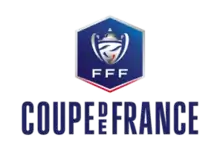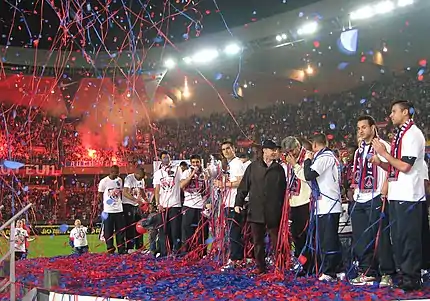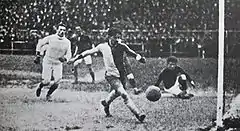Coupe de France
The Coupe de France, also known as the Coupe Charles Simon, is the premier knockout cup competition in French football organized by the French Football Federation (FFF). It was first held in 1917 and is open to all amateur and professional football clubs in France, including clubs based in the overseas departments and territories. Between 1917 and 1919, the competition was called the Coupe Charles Simon, in tribute of Charles Simon, a French sportsman and the founder of the French Interfederal Committee (the ancestor of the French Football Federation), who died in 1915 while serving in World War I. The final is played at the Stade de France and the winner qualifies for the group stage of the UEFA Europa League and a place in the Trophée des Champions match. A concurrent women's tournament is also held, the Coupe de France Féminine.
 | |
| Organising body | French Football Federation |
|---|---|
| Founded | 1917 |
| Region | France and overseas France |
| Number of teams | 8,506 |
| Qualifier for | UEFA Europa League |
| Domestic cup(s) | Trophée des Champions |
| Current champions | Paris Saint-Germain (13th title) |
| Most successful club(s) | Paris Saint-Germain (13 titles) |
| Television broadcasters | France Télévisions Eurosport |
| Website | FFF – Coupe de France |
Combined with random draws and one-off matches (no replays), the Coupe de France can be difficult for the bigger clubs to win. The competition is usually beneficial to the amateur clubs as it forces higher-ranked clubs, usually professional clubs, to play as the away team when drawn against lower-league opposition if they are competing two levels below them. Despite the advantages, only three amateur clubs have reached the final since professionalism was introduced in French football in 1932: Calais RUFC in 2000 and Les Herbiers VF in 2018. Two clubs from outside Ligue 1 have won the competition, Le Havre in 1959 and Guingamp in 2009. The reigning champions are Paris Saint-Germain, who defeated Saint-Étienne in the final of the 2019–20 competition.
History
The Coupe de France was created on 15 January 1917 by the French Interfederal Committee (CFI), an early predecessor of the French Football Federation. The idea was pushed by the federation's general secretary Henri Delaunay and under union sacrée, the competition was declared open to all clubs, amateur and professional, though professionalism in French football at the time was non-existent. The major clubs in France objected to the notion that all clubs should be allowed to enter. However, the federation dispelled their complaints and declared the competition would remain as is. Due to the minimal requirements to enter, the first competition featured 48 clubs. By 1948, the number had increased to 1,000 and at present, the competition features more than 7,000 clubs. Due to the initial increase in clubs, the federation created preliminary rounds beginning with the 1919–20 season. The following season, they added a second preliminary round. As of today, the competition contains eight regional rounds with some regions containing as many as ten.
The first Coupe de France victors were Olympique de Pantin who defeated FC Lyon 3–0 at the Stade de la Légion Saint-Michel in Paris in front of 2,000 spectators. The following year, the competition was shifted to the Parc des Princes and drew 10,000 supporters to the final that saw CASG Paris defeat Olympique de Paris 3–2. The competition alternated between many stadiums during its early years playing at the Stade Pershing from 1920–1924 before switching to the Stade Olympique Yves-du-Manoir in Colombes. The competition lasted a decade there before returning to the Parc des Princes in 1938. In 1941, the final was held at the Stade de Paris. The following year, the final returned to Colombes and remained there until moving to the Parc des Princes permanently following its renovation, which made it the largest in terms of attendance in France.
There are vastly more amateur than professional clubs in France, and the competition regularly produces surprises. The best performance by an amateur club in the competition is usually awarded the Petit Poucet Plaque. One of the competition's biggest upsets occurred in February 1957 when Algerian club SCU El Biar defeated Stade de Reims who had players such as Robert Jonquet, Michel Hidalgo, Léon Glovacki, and Just Fontaine. One of the more recent successes of an amateur club occurred during the 1999–2000 competition when Championnat de France amateur club Calais RUFC reached the final. Calais, composed of doctors, dock workers, and office clerks, started the competition in the 5th round and, after defeating fellow amateurs, beat clubs Lille, Langon-Castets, Cannes, Strasbourg, and Bordeaux to advance to the final. Calais' road to the final was a prime example of the major advantages amateur clubs had with the club playing all of its matches at home beginning with the Round of 64 match. In the final the club lost to Nantes 2–1 despite scoring first.
Professional clubs have continued to express their displeasure with the advantages amateur clubs receive in the competition with many of their complaints being directly associated with their hosting of matches. Coupe de France rules explicitly state that teams drawn first during the draw are granted hosting duties for the round, however, if the club drawn second is competing two levels below the club drawn first, then the hosting duties will be given to the second club drawn. Many clubs have subsequently complained that, due to the amateur clubs not having adequate funds, the stadiums they play in are extremely unkempt. The resulting differences led to the clubs represented by the Ligue de Football Professionnel forming their own cup competition, the Coupe de la Ligue. More recently, amateur clubs have begun to move to more established stadiums for their Coupe de France matches with their primary reason being to earn more money at the gate due to more established stadiums having the ability to carry more spectators.
The winner of the Coupe de France trophy normally holds on to the trophy for one year to put in on display at their headquarters before returning it to the French Football Federation. In the early 1980s, the cup was stolen, but was retrieved by the authorities quickly. Since 1927, the President of France has always attended the cup final and presented the trophy to the winning team's captain. Gaston Doumergue was the first French president to attend the final.
Competition format
Similar to other countries' cup competitions, the Coupe de France is a knockout tournament with pairings for each round drawn at random. Each tie is played through a single leg. If a match ends in a draw, penalties are held.[1] Prior to 1967, the competition had no extra time nor penalty shootouts and instead allowed replays, similar to the FA Cup. This style was abandoned following three straight draws between Olympique Lyonnais and amateur club Angoulême CFC, which resulted in the federation flipping a coin to decide which club advanced. For the 1968–69 season, extra time was introduced and, two years later, the penalty shootout was instituted. Following the 1974–75 season, replays were scrapped.
There are a total of 14 rounds in the competition. However, rounds in the competition are determined through each region in France with one of the main reasons being to reduce travel costs. Depending on the region, the number of rounds may vary from four to as many as eight with each region sending a set number of clubs to the 7th round. The regions conduct rounds of matches up until the 7th round when professional clubs enter the competition. All of the clubs are then split and drawn against each other randomly, regardless of regional affiliation though geographical pots are made prior to the draw. In the overseas departments and territories, territories such as Guadeloupe, Martinique, French Guiana, and Réunion establish their own knockout competition, similar to the regions in France, though only one club from each region is allowed to enter. This number later rose to two for some overseas regions. Territories like Mayotte, French Polynesia, and New Caledonia allow the winner of their cup competitions to enter the 7th round, such as when AS Mont-Dore won the 2009 edition of the New Caledonia Cup to earn qualification for the 2009–10 Coupe de France.
As well as being presented with the trophy, the winning team also qualifies for the UEFA Europa League. If the winner has already qualified for the UEFA Champions League via the league, the UEFA Europa League place goes to the next highest placed finisher in the league table. Overseas teams are also eligible for UEFA qualification.[2]
Format for the 2020–21 Coupe de France
- In the first two rounds the teams below the National 3 enter.
- National 2 teams enter the third round.
- Championnat National teams enter the fourth round.
- Ligue 2 teams enter the eight round.
- Ligue 1 teams enter the round of 64.
Numbering
In Coupe de France matches, players are restricted to wearing the shirt numbers 1–18 regardless of the player's squad number. The starters are given the numbers 1–11.
Overseas teams
The cup was open to overseas teams starting in the 1961–62 season. In the 1974–75 season, the Golden Star was the first overseas team to beat a mainland team. The Martinique club beat US Melun 2–1 in the replay after 1–1 in the first game. The Golden Star was then the first overseas team to reach the round of 64. In the 1988–89 season, Le Geldar de Kourou was the first overseas team to reach the round of 32.In the 2019–20 season, Saint-Pierroise was the second overseas team to reach the round of 32. In the following season, Club Franciscain was the third overseas team to reach the round of 32.
Sponsorship
The Coupe de France does not have a primary sponsor of the competition, but allows sponsors of the French Football Federation to showcase themselves on club's kits at the expense of the club's sponsors. Among them include SFR, Caisse d'Epargne, Crédit Agricole, Sita-Suez, and Carrefour.[3]
Records

Paris Saint-Germain have a record of 13 Coupe de France titles, following the result of the 2019–20 cup.[4] Marseille have appeared in the most finals having played in 19. The Parisian club won a cup 'double' (i.e. the Coupe de France and the Coupe de la Ligue in the same season) in 1995, 1998, 2015, 2016, 2017, 2018 and 2020. Marseille are one of four clubs who have suffered two consecutive finals defeats, as the Bouches-du-Rhône-based club lost to Paris Saint-Germain in 2006 and then to Sochaux the following season.
Due to the early dominance of Parisian clubs during the early run of the competition and along with PSG's consistency, the Île-de-France region has the most Coupe de France champions having produced 24. The region is followed by Provence-Alpes-Côte d'Azur with Marseille being the region's most successful club.
Managers Guy Roux and André Cheuva share the honour of having managed four Coupe de France winning clubs. The most successful players are Dominique Bathenay, Alain Roche, and Marceau Sommerlynck who all won five titles. Éric Pécout of Nantes and Jean-Pierre Papin are joint top-scorers of the competition final having each converted a hat trick in their only appearances in the ultimate match. In 1947, Roger Vandooren scored the fastest goal in the final's history converting after 29 seconds for his club Lille in their 2–0 win over Strasbourg.
Media coverage
France
The Coupe de France currently has a broadcasting agreement with France Télévisions, the French public national television broadcaster, and Eurosport since the 1996/97 until 2021/22 season. The Coupe de France final is co-aired on France 2 since 1975 until 2022 (exclude 1984 until 2006).[5]
Free
| Television channel | Period |
|---|---|
| ORTF | 1955–1975 |
| France Télévisions | 1975–1984 |
| 2006–2022 | |
| TF1 | 1984–2006 |
Winners
Performance by club
References
- https://www.lavoixdunord.fr/771589/article/2020-06-30/reglement-de-la-coupe-de-france-la-fff-siffle-la-fin-des-prolongations
- "The longest journeys in UEFA football history". UEFA.com. Union of European Football Associations. 20 August 2015. Retrieved 24 July 2020.
- FFF gets sponsorship boost as PMU comes on board
- "Mbappé injury in final mars PSG winning 13th French Cup". Yahoo Sports. 24 July 2020. Retrieved 24 July 2020.
- "Coupes - La FFF, France TV et Eurosport renouvellent leur partenariat pour 4 ans - FFF". FFF (in French). Retrieved 2 February 2020.
External links
- Official page on FFF site (in French)
- Coupe de France summary(in English)(SOCCERWAY)
